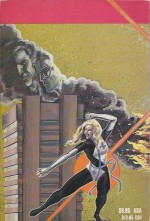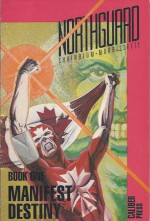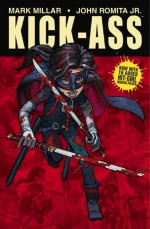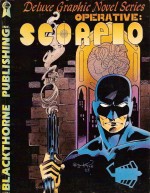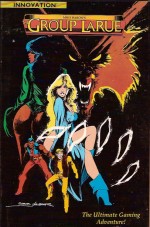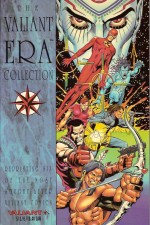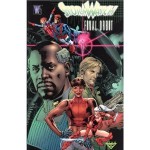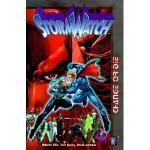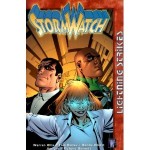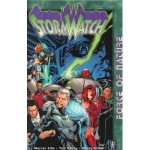
By Jeff Yang, Parry Shen, Keith Chow, Jerry Ma & various (The New Press)
ISBN: 978-1-59558-824-1
The very best thing about old comics periodicals, and a factor sadly deficient in most graphic novels these days, is the lack of variety. Those venerable weeklies and monthlies were generally stuffed with different strips and features offering a host of entertainment options that contemporary books just can’t match.
That’s certainly not the case in this marvellous collection of new stories supervised by Jeff Yang, Parry Shen, Keith Chow and Jerry Ma, who first came to Funnybook fans’ attention in 2009 with the satirical shared-universe superhero book Secret Identities. That tome showcased the talents of exclusively Asian American creators in comics amalgamating the US industry’s signature genre with the social, cultural and entertainment influences of a non-WASP, non-Jewish (it’s easy to argue that the American comicbook was primarily invented by immigrants – and largely Jewish ones at that) talent pool to produce a whole new take on the sequential narrative experience.
Now this fresh collection expands on that initial offering with new adventures set in that New Universe, as well as many sidebar and only notionally linked cartoon yarns, from a host of gifted writers and artists whose origins and ethnicity stem from Asia, India and all points East.
An overarching storyline links the tales here as the Eastern archetypes which permeate Western fiction – the Brute, the Brain, the Temptress, the Alien and the Manipulator – are reclaimed and transformed into the motivating force which links the Secret Identities tale into one longer epic, with each chapter then supplemented by additional, less canonical strips.
Thus the prologue set up of ‘The Sacrifice’ written by Yang, Shen & Chow and illustrated by Ma introduces a quintet of otherworldly demons who want to break back into our helpless world. Bo-Kwun the Manipulator, Kum-Sau the Brute, Zhi-Lik the Brain, Yi-Heung the Alien and Ngau-Yun the Temptress – collectively known as Ng Duk, the Five Venoms – were long ago banished and barred by two ancient Djinn heroes. Their tenuous triumph is now sustained by a cult of ever vigilant warrior priests…
The saga further builds in ‘Burn’, by Jimmy & Jerry Ma, as a masked westerner in 19th century China brought poisonous flowers to destroy the people’s way of life, even contaminating the soul of their greatest champion The Commissioner…
The story proper begins in America during the Gold Rush with ‘The Brute – Driving Steel: the Breaking’ by Yang & Krishna M. Sadasivam, as wandering oriental outcast Ifrit and his negro partner John Henry are tricked into breaking the Mirror of Divine Immortals and release the Five Venoms…
Tangential follow-ups then offer a new perspective on an old story in ‘Master Tortoise & Master Hare’ by Howard Wong & Jamie Noguchi, Bernard Chang’s ‘Showtime’ begins a demonic basketball battle resolved on the artist’s own website, whilst ‘Solitary’ (Michael Kang, Edmund Lee & Glenn Urieta) examines the contemporary gang scene and family bonds before ‘Clean Getaway’ (Jamie Ford & A.L. Baroza) perfectly pastiches EC crime comics, complete with faux cover from Tales of the Orient #12…
‘The Temptress’ leads off the next chapter of the ongoing epic with ‘Bai, Bai, Bai Tsai’ by Yang, Martin Hsu & Sophia Lin as the creators reference manga styles to relate how second generation kid heroes Magical Girl, Super Deformed and Hell Kitty solve an ancient mystery and uncover sinister exploitation involving a cancelled cartoon show after which ‘Ching Shih, Queen of Pirates’, by Natalie Kim & Robin Ha, details the history of a 19th century demimonde who uniquely took control of her own destiny.
Another kind of seductress figures in the bittersweet romantic fable ‘The Regrets We Talk About’ by Fred Chao whilst ‘Heroes Without a Country: Tokyo Rose’ from Daniel Jae Lee & Dafu Yu provides a delightfully smart WWII superhero spy-thriller and Amy Chu, Larry Hama & Craig Yeung cleverly recall a bad time for Japanese-American Nisei in ‘The Date’…
A full-colour glossy ‘Gallery’ of concepts and characters follows featuring art and synopses for ‘Adam Warrock’ by Eugene Ahn & Ming Doyle, ‘Revolution Shuffle’ by Bao Phi & GB Tran, ‘Tempest’ from Kai Ma & Eric Kim, ‘The Walkman’ hilariously conceived by Aaron Takahashi & Mukesh Singh, ‘Angry Asian Man’ Phil Yu & Jerry Ma, the utterly enchanting ‘Mei the Alien’ by Koji Steven Sakai & Deodata Pangandoyon, ‘Camp Mech’ by Eric Nakamura & Sara Saedi, and Thenmozhi Soundararajan & Saumin Suresh Patel’s ‘The Death Stalker’…
‘The Brain’ then takes centre stage for the unfolding epic in ‘Hide and Sikh’ from Parry Shen & Jeremy Arambulo wherein the atomic children born of the nuclear devastation of Hiroshima and Nagasaki grow into their dormant power and uncover a huge secret of metahuman genesis…
The remainder of the chapter then focuses on the dreaming world described by ‘The Power of Petunia’ (Joy Osmanski & Yasmin Liang), Paul Wei & Chi-Yun Lau’s classy future shocker ‘Drones and Droids’, a parable of High School popularity contests resulting in ‘Camden’s Revenge’ by Keiko Agena & Louie Chin and a darkly traumatic decision made in ‘Metatron’ by Stuart Ng.
Possibly my very favourite tale in this masterful monochrome compilation is Greg Pak & Takeshi Miyazawa’s ‘Los Robos, Arizona’, joyously referencing the wide-eyed wonder of manga boys and their giant alien Mecha as a young cadet is selected by fate to befriend an incredible metal visitor, whilst Ford & Baroza again charm with new nostalgia in ‘A Cut Above’ parodying EC horror with a snippet from Weird Asian Science #46…
The over-epic resumes with ‘The Alien’ in ‘Peril: Welcome to the Terror’ from Keith Chow & Jerry Castro, returning to Goldfield, Arizona in 1900 and an outrage against the Chinese immigrant workers, before jumping to today and a manhunt for a misunderstood hero steeped in the horrors of then and the technology of tomorrow…
Kripa Joshi then takes a swingeing pot-shot at a culture of callous bullying in ‘Miss Moti, Shattered’, Johann Choi reveals the darkness of ‘The Stranger’ and Traci Honda deliciously, wordlessly plays childish games with ‘Personal Monsters’.
Tanji Chopra & Alice Meichi Li take a long dark look at the sordid future of negotiable affection in ‘Weightless’, whilst Angela Veronica Wong, Reinhardt Suarez, Christine Norrie & Craig Yeung explore the endless anticipation of kid superhumans and their insatiable aspirations in ‘A Dream of Flying’, before ‘Fashion Never Dyes’ again displays Ford & Baroza’s delight with EC thrillers by providing a shocker from the tragically non-existent Uncanny Tales of the Yellow Peril #27.
‘The Manipulator’ at last steps up in ‘Hibakusha: Secrets’ by Shen & Sean Chen as a determined team of atomic heroes uncover the clandestine nature of the Arizona scandal in a spectacular action adventure, whilst the ancillary aspects include ‘Push’ (Jennifer S. Fang, Ace Continuado & Julian San Juan) which reveals what happens when Yankee superhero brawn meets studious Asian serial killer planning, whilst ‘Persons of Mass Destruction’, by Gary Jackson & Cesar P. Castillo, offers a chilling dose of metahuman realpolitik in relation to the “threat†of North Korea.
Also on view are Ren Hsieh & Bryan Lee’s alien incursion ‘The Merciful’, stunning kung fu doomsday parable ‘Qi Lai!’ by Roger Ma, Dheeraj Verma & Tak Toyoshima, the indescribably odd ‘Occupy Ethnic Foods’ courtesy of a solo flying Toyoshima, and the gloriously hip strip featuring the maternal tribulations of a rather harried ‘Shadow Hero’ by Gene Luen Yang & Sonny Liew…
Yang, Shen, Chow & Urieta then bring it all to a triumphal finale in ‘The Sealing’ as the disparate heroes unite to battle the Five Venoms and restore the Mirror of Divine Immortals through an ultimate sacrifice or two, wrapping up this stirring and staggeringly impressive anthology celebration in grand manner.
Finally the publishing project further underscores its debt of thanks to the constantly-changing nature of the American Experiment in illustrated Epilogue. ‘The Vilcek Story’ (by Jeff Yang & Wendy Xu) précis the history of the family of Czechoslovakian Jews who fled to the USA during the years of Nazi atrocity and, after building successful lives, set up a foundation which celebrates and supports the ongoing immigrant experience – and funded this collection…
Combining the best aspects of a vast panoply of storytelling traditions and artistic styles, Shattered is a bold experiment in identity and assimilation that will amaze comics fans in search of something a little different…
Compilation © 2012 Jeff Yang, Parry Shen, Keith Chow and Jerry Ma. Individual pieces © 2012 each author. All rights reserved.

